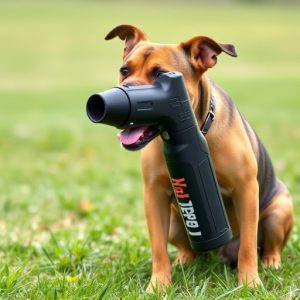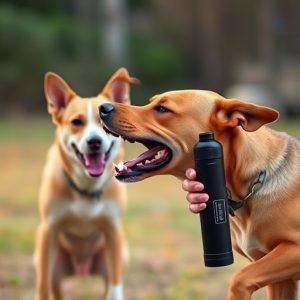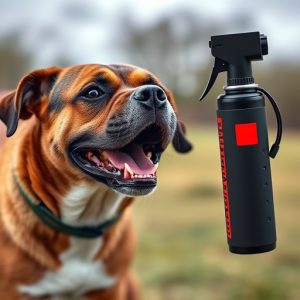Mace Dog Spray Defense: Lawful Use, Ingredients, and Success Stories
Dog spray, designed for canine self-defense, is subject to strict legal guidelines focusing on publi…….
Dog spray, designed for canine self-defense, is subject to strict legal guidelines focusing on public safety and responsible use. Reputable manufacturers offer products with varying safe pepper spray strengths, from 0.5% to 2%, catering to different dog breeds and behaviors. Understanding local laws, ingredient quality, and concentration is crucial for effective and minimal risk deterrence. Mace dog spray, a popular choice, utilizes capsaicin to disrupt aggressive dogs without severe harm. Legal defenses for responsible use have yielded successful outcomes, establishing safe pepper spray strengths as justifiable self-defense against aggressive canines.
In today’s legal landscape, understanding the use of mace dog spray is crucial. This article delves into the intricacies of dog spray, its types, safety standards, and legal considerations, including when its use is justified. We explore the active ingredients and strengths of mace dog spray, offering insights to build a robust defense against unjust charges. Real-world scenarios and success stories highlight the importance of knowing your rights in interactions with canine safety products like safe pepper spray designed for dogs.
- Understanding Dog Spray: Types and Safety Standards
- Legal Considerations: When is Dog Spray Use Justified?
- Evaluating Mace Dog Spray: Active Ingredients and Strengths
- Defense Strategies: Building a Case Against Unjust Charges
- Real-World Scenarios: Success Stories and Legal Precedents
Understanding Dog Spray: Types and Safety Standards
Dog spray, also known as mace or pepper spray for dogs, is a non-lethal self-defense tool designed to incapacitate and deter potential threats. It’s crucial to understand that not all dog sprays are created equal, with significant variations in safe pepper spray strength for dogs. Manufacturers typically offer different formulas tailored to address specific needs, from training aids to emergency defenses.
Safety standards play a pivotal role in ensuring the responsible use of dog spray. Reputable brands adhere to stringent regulations, guaranteeing the product’s effectiveness while minimizing risks. These standards encompass ingredient quality, concentration levels, and application guidelines. Understanding these aspects is vital for anyone considering a legal defense strategy involving dog spray, as it directly impacts its safety and efficacy in various scenarios.
Legal Considerations: When is Dog Spray Use Justified?
In many jurisdictions, dog spray, or safe pepper spray designed for canine use, has specific legal considerations and justifications for its application. The legality of using dog spray is primarily based on self-defense and public safety, with strict regulations in place to ensure it’s not misused. Law enforcement officers and trained professionals are typically authorized to carry and use dog spray under specific circumstances, such as when a dog displays aggressive or hostile behavior that poses an imminent threat.
The ‘safe pepper spray strength for dogs’ is crucial; it should be formulated to cause minimal harm to both the target animal and bystanders while effectively deterring and controlling the canine. The concentration and delivery system of the spray must adhere to local laws, ensuring it’s not overly potent or dangerous. It’s essential to consult legal experts and industry regulations to understand when and how dog spray can be legally employed to safeguard individuals and property without causing unnecessary harm.
Evaluating Mace Dog Spray: Active Ingredients and Strengths
Mace dog spray, a popular choice among pet owners and professionals alike, is designed to effectively deter aggressive dogs while prioritizing animal safety. Evaluating its active ingredients is crucial when considering its effectiveness and safe pepper spray strength for dogs. The primary active ingredient in many dog sprays is capsaicin, the compound responsible for the heat and irritation sensation associated with chili peppers. This component is typically mixed with other additives to enhance its potency and ensure a quick response.
The strength of mace dog spray varies across different brands and formulations. Safe pepper spray for dogs should have a low concentration to minimize potential harm while still being potent enough to deter an attack. Concentrations range from 0.5% to 2%, with lower concentrations being suitable for sensitive areas like the face, paws, and muzzle. Higher strengths may be recommended for larger breeds or dogs with more powerful jaws, ensuring the spray can effectively disrupt their behavior without causing severe discomfort or health issues.
Defense Strategies: Building a Case Against Unjust Charges
When facing charges related to using mace dog spray, a robust legal defense strategy is paramount. The first step involves understanding the specific laws and regulations surrounding the use of pepper spray for dogs in your jurisdiction. It’s crucial to differentiate between reasonable force and excessive force when it comes to animal control measures. Legal teams can challenge the prosecution’s case by examining the circumstances leading up to the incident, including whether the safe pepper spray strength for dogs was appropriately used as a last resort.
Additionally, building a strong alibi and gathering compelling evidence can weaken the prosecution’s argument. This may include witness testimonies, video footage, or expert opinions that demonstrate the necessity of the spray to control or protect against an aggressive animal. By presenting a well-structured defense that highlights the proportionality of the force used, legal representatives can help their clients navigate the legal complexities surrounding mace dog spray incidents successfully.
Real-World Scenarios: Success Stories and Legal Precedents
In real-world scenarios, the legal defense surrounding dog spray, specifically those with safe pepper spray strengths designed for canine use, has seen varied outcomes. Many success stories involve responsible pet owners who used non-lethal force to protect themselves or their property from aggressive dogs, only to be cleared of all charges due to the reasonable use of this alternative to traditional firearms or lethal force.
Legal precedents have established that when dog spray is deployed in a manner consistent with its intended purpose – to incapacitate temporarily and deter without causing serious harm – it can be justified as self-defense. Courts have also acknowledged the growing acceptance of safe pepper spray strengths for dogs, recognizing them as a proportionate response to threats posed by out-of-control canines. These precedents have not only protected owners who acted in self-defense but also clarified the legal boundaries surrounding the use of non-lethal force against aggressive animals.
In conclusion, understanding the legal implications of dog spray use is crucial when defending against unjust charges. By grasping the types, safety standards, and active ingredients of pepper spray designed for dogs, along with navigating real-world scenarios and legal precedents, individuals can build strong defenses. Remember that knowledge is power; staying informed about safe pepper spray strengths for dogs and employing effective defense strategies can significantly impact outcomes in such cases.


